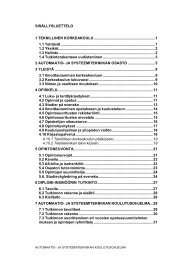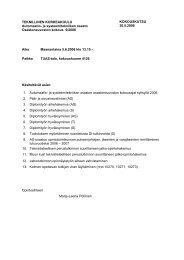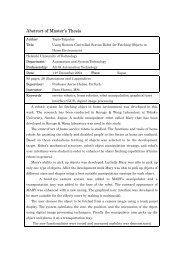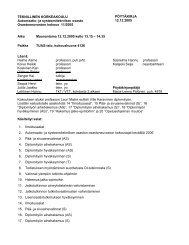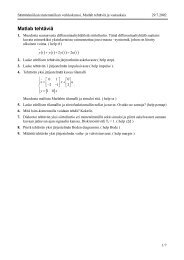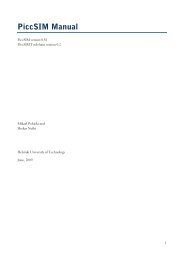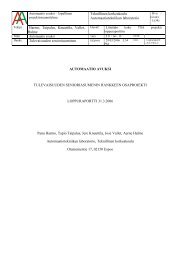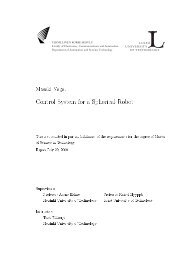FEM <strong>modelling</strong> <strong>of</strong> a <strong>bellows</strong> <strong>and</strong> a <strong>bellows</strong>-<strong>based</strong> <strong>micromanipulator</strong>III. ModellingThe pressure range is much larger than the pressure that is used in the <strong>micromanipulator</strong>.Effectively, the measurements 19 showed that the typical maximum displacement <strong>of</strong> one<strong>bellows</strong> was around 150 [µm], which corresponds on our graph to an applied pressure <strong>of</strong>roughly 20 [mN/mm 2 ]. In that case, Z does not vary more than approximately 1,20%. Hence,once more, a constant value for Z can be assumed by computing an average.Z = 6,6·10 -3 [mm 3 /mN] (3.16)After this, it is time to take a look on the radial displacement occurring when applying aforce inside the <strong>bellows</strong>. The consequence is effectively expected to be minor, since theeffective surface on which the pressure applies in radial direction is very small comparing onthat on which the pressure is applied in the axial direction, as illustrated by figure 24. Tomeasure the radial displacement, the node having the largest motion is needs to be checked.Actually, that node E is showed on figure 24 <strong>and</strong> corresponds to the external shape <strong>of</strong> thewhole <strong>bellows</strong>. There is no need to extend the simulation result <strong>of</strong> one ring's to the entire<strong>bellows</strong>, since it is exactly the same.Figure 24Illustration <strong>of</strong> the amount <strong>of</strong>pressure effectively acting inradial direction, incomparison with thatbehaving in axial direction.Next table shows the comparison between axial <strong>and</strong> radial displacement:EPressure[mN/mm 2 ]y-displacement[mm]Radial motion[µm]Ratio25 0,202584 0,1667918 82350 0,406616 0,3297720 81175 0,611811 0,4889844 799100 0,817910 0,6444888 788125 1,024680 0,7963584 777150 1,231900 0,9446724 767175 1,439400 1,0895208 757200 1,647000 1,2309972 747The mean value <strong>of</strong> axial versus radial displacement is about 783. It means that the radialdisplacement is almost three order <strong>of</strong> size smaller than the axial one, <strong>and</strong> can therefore freelybe neglected in further simulations.3.5 TolerancesIt is known from the manufacturer's data sheets that the <strong>bellows</strong>' proportions have sometolerances, as for instance the inner diameter B, which can for example vary up to ±3,5%.These dimension mismatches will certainly influence some parameters, as the spring-rate,19 Made in Tampere University <strong>of</strong> Technology33
III. ModellingFEM <strong>modelling</strong> <strong>of</strong> a <strong>bellows</strong> <strong>and</strong> a <strong>bellows</strong>-<strong>based</strong> <strong>micromanipulator</strong>which is given by Servometer with ±30% accuracy. That's why it is important to find out howmuch previous simulation results will be affected by them.Unfortunately the exact tolerance <strong>of</strong> all geometrical data <strong>of</strong> the <strong>bellows</strong> are not known. Ithas also been previously noticed that not all <strong>of</strong> them affect the behaviour significantly. Analteration <strong>of</strong> 20% <strong>of</strong> the radii r 1 <strong>and</strong> r 2 , for example, instigates an axial displacementmodification <strong>of</strong> only 0.2%. That's why a choice was made, <strong>and</strong> only the most relevantparameters were selected, namely the wall thickness t, the convolution pitch D <strong>and</strong> the innerdiameter B.Next tolerances have been fixed for the three parameters:• D: ±70% D = 0.783 ±0.254 [mm]• B: ±3% B = 3.810 ±0.13 [mm]• T: ±10% t = 38.100 ±3.8 [µm]The manufacturer doesn't give any tolerance for t. But since it is a very sensitive parameter,it was decided anyway to include this parameter in the following tables. A large tolerance <strong>of</strong>±10% was fixed for it. In each <strong>of</strong> the next sections, the simulation was performed six times,changing at each stage only one <strong>of</strong> the three parameters to its upper or lower tolerance value.3.5.1 SPRING-RATE TOLERANCESA force <strong>of</strong> 10 [mN] on the top <strong>of</strong> the <strong>bellows</strong> was applied, with the same conditions as in theforegoing spring-ratio simulation 20 .t [µm] B [mm] D [mm] k [mN/mm]38,1 3,81 0,7832 1259 (21)34,3 3,81 0,7832 961 (-23%)41,9 3,81 0,7832 1599 (+27%)38,1 3,68 0,7832 1101 (-13%)38,1 3,94 0,7832 1465 (+16%)38,1 3,81 0,5588 24'505 (-19%)38,1 3,81 1,0668 40'493 (+34%)The tolerance <strong>of</strong> the convolution pitch D cannot be extended to the entire <strong>bellows</strong>.Effectively, D is a mean value <strong>of</strong> the constituting rings <strong>of</strong> the <strong>bellows</strong>. It is impossible that allpitches have, for instance, the upper tolerance, because it would signify that the resultant<strong>bellows</strong>' length would be 25.6 [mm]! This is unrealistic, <strong>and</strong> would <strong>of</strong> course never passServometer's quality control! It wouldn't be therefore consistent to take the entire <strong>bellows</strong>'spring-rate with extreme convolutions pitches' value. That's why in the table, the spring ratiois computed <strong>and</strong> compared to only one ring's value 22 .One can notice through these results that the spring ratio is affected by all <strong>of</strong> the parameters.A 3%-variation <strong>of</strong> the inner diameter B changes the spring rate up to 16% <strong>of</strong> its nominalvalue. But the thickness t doesn't change so much as the simulated spring-rate, as expectedreferring to formula (3.4) given by Servometer. Effectively, when t changes up to 10%, thespring rate is only affected by 27%.20 See section 3.2.21 This first table row refers to the result found with nominal values.22 The spring-rate k <strong>of</strong> one ring is 30'211 [mN/mm].34



